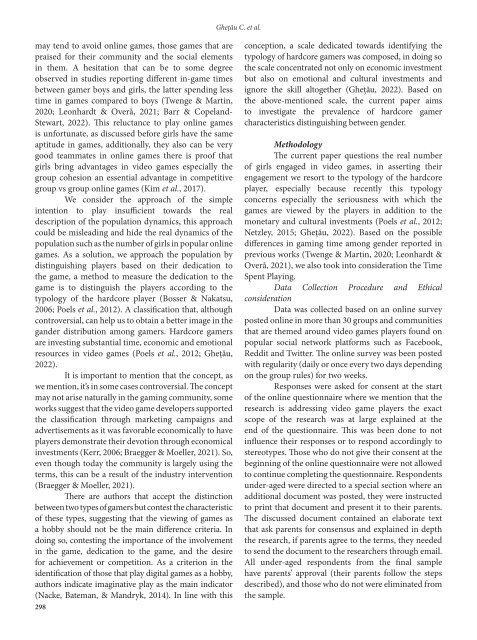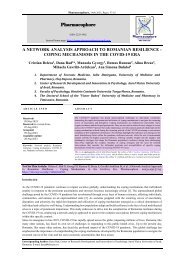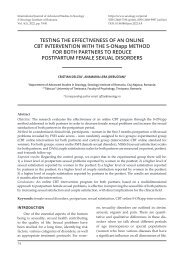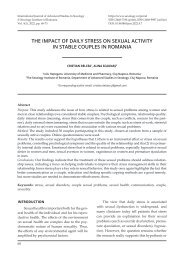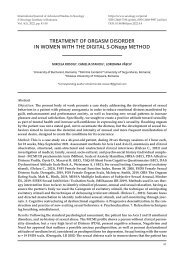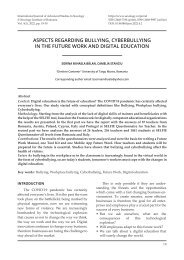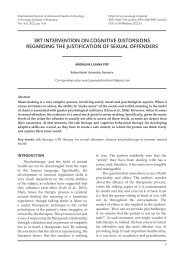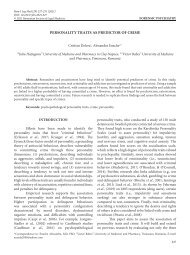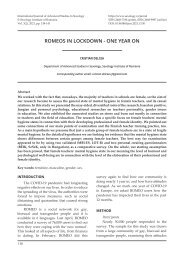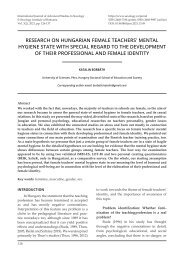297-301
You also want an ePaper? Increase the reach of your titles
YUMPU automatically turns print PDFs into web optimized ePapers that Google loves.
Ghețău C. et al.<br />
may tend to avoid online games, those games that are<br />
praised for their community and the social elements<br />
in them. A hesitation that can be to some degree<br />
observed in studies reporting different in-game times<br />
between gamer boys and girls, the latter spending less<br />
time in games compared to boys (Twenge & Martin,<br />
2020; Leonhardt & Overå, 2021; Barr & Copeland-<br />
Stewart, 2022). This reluctance to play online games<br />
is unfortunate, as discussed before girls have the same<br />
aptitude in games, additionally, they also can be very<br />
good teammates in online games there is proof that<br />
girls bring advantages in video games especially the<br />
group cohesion an essential advantage in competitive<br />
group vs group online games (Kim et al., 2017).<br />
We consider the approach of the simple<br />
intention to play insufficient towards the real<br />
description of the population dynamics, this approach<br />
could be misleading and hide the real dynamics of the<br />
population such as the number of girls in popular online<br />
games. As a solution, we approach the population by<br />
distinguishing players based on their dedication to<br />
the game, a method to measure the dedication to the<br />
game is to distinguish the players according to the<br />
typology of the hardcore player (Bosser & Nakatsu,<br />
2006; Poels et al., 2012). A classification that, although<br />
controversial, can help us to obtain a better image in the<br />
gander distribution among gamers. Hardcore gamers<br />
are investing substantial time, economic and emotional<br />
resources in video games (Poels et al., 2012; Ghețău,<br />
2022).<br />
It is important to mention that the concept, as<br />
we mention, it’s in some cases controversial. The concept<br />
may not arise naturally in the gaming community, some<br />
works suggest that the video game developers supported<br />
the classification through marketing campaigns and<br />
advertisements as it was favorable economically to have<br />
players demonstrate their devotion through economical<br />
investments (Kerr, 2006; Braegger & Moeller, 2021). So,<br />
even though today the community is largely using the<br />
terms, this can be a result of the industry intervention<br />
(Braegger & Moeller, 2021).<br />
There are authors that accept the distinction<br />
between two types of gamers but contest the characteristic<br />
of these types, suggesting that the viewing of games as<br />
a hobby should not be the main difference criteria. In<br />
doing so, contesting the importance of the involvement<br />
in the game, dedication to the game, and the desire<br />
for achievement or competition. As a criterion in the<br />
identification of those that play digital games as a hobby,<br />
authors indicate imaginative play as the main indicator<br />
(Nacke, Bateman, & Mandryk, 2014). In line with this<br />
298<br />
conception, a scale dedicated towards identifying the<br />
typology of hardcore gamers was composed, in doing so<br />
the scale concentrated not only on economic investment<br />
but also on emotional and cultural investments and<br />
ignore the skill altogether (Ghețău, 2022). Based on<br />
the above-mentioned scale, the current paper aims<br />
to investigate the prevalence of hardcore gamer<br />
characteristics distinguishing between gender.<br />
Methodology<br />
The current paper questions the real number<br />
of girls engaged in video games, in asserting their<br />
engagement we resort to the typology of the hardcore<br />
player, especially because recently this typology<br />
concerns especially the seriousness with which the<br />
games are viewed by the players in addition to the<br />
monetary and cultural investments (Poels et al., 2012;<br />
Netzley, 2015; Ghețău, 2022). Based on the possible<br />
differences in gaming time among gender reported in<br />
previous works (Twenge & Martin, 2020; Leonhardt &<br />
Overå, 2021), we also took into consideration the Time<br />
Spent Playing.<br />
Data Collection Procedure and Ethical<br />
consideration<br />
Data was collected based on an online survey<br />
posted online in more than 30 groups and communities<br />
that are themed around video games players found on<br />
popular social network platforms such as Facebook,<br />
Reddit and Twitter. The online survey was been posted<br />
with regularity (daily or once every two days depending<br />
on the group rules) for two weeks.<br />
Responses were asked for consent at the start<br />
of the online questionnaire where we mention that the<br />
research is addressing video game players the exact<br />
scope of the research was at large explained at the<br />
end of the questionnaire. This was been done to not<br />
influence their responses or to respond accordingly to<br />
stereotypes. Those who do not give their consent at the<br />
beginning of the online questionnaire were not allowed<br />
to continue completing the questionnaire. Respondents<br />
under-aged were directed to a special section where an<br />
additional document was posted, they were instructed<br />
to print that document and present it to their parents.<br />
The discussed document contained an elaborate text<br />
that ask parents for consensus and explained in depth<br />
the research, if parents agree to the terms, they needed<br />
to send the document to the researchers through email.<br />
All under-aged respondents from the final sample<br />
have parents’ approval (their parents follow the steps<br />
described), and those who do not were eliminated from<br />
the sample.


